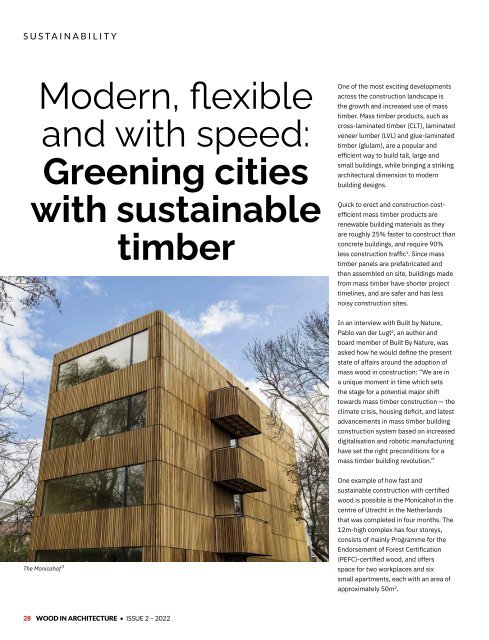Wood In Architecture Issue 2, 2022
First published in 2017, Wood in Architecture (WIA) is a bi-annual trade magazine devoted to the international timber construction sector. The newest addition to the Panels & Furniture Group of wood magazines, WIA features in-depth insights to the latest industry news, incredible projects and leading trade events. WIA is an advocate for timber as a material of choice for today’s built environment, and is the perfect source of inspiration for architects, builders, engineers and interior designers across the globe.
First published in 2017, Wood in Architecture (WIA) is a bi-annual trade magazine devoted to the international timber construction sector. The newest addition to the Panels & Furniture Group of wood magazines, WIA features in-depth insights to the latest industry news, incredible projects and leading trade events. WIA is an advocate for timber as a material of choice for today’s built environment, and is the perfect source of inspiration for architects, builders, engineers and interior designers across the globe.
Create successful ePaper yourself
Turn your PDF publications into a flip-book with our unique Google optimized e-Paper software.
SUSTAINABILITY<br />
Modern, flexible<br />
and with speed:<br />
Greening cities<br />
with sustainable<br />
timber<br />
One of the most exciting developments<br />
across the construction landscape is<br />
the growth and increased use of mass<br />
timber. Mass timber products, such as<br />
cross-laminated timber (CLT), laminated<br />
veneer lumber (LVL) and glue-laminated<br />
timber (glulam), are a popular and<br />
efficient way to build tall, large and<br />
small buildings, while bringing a striking<br />
architectural dimension to modern<br />
building designs.<br />
Quick to erect and construction costefficient<br />
mass timber products are<br />
renewable building materials as they<br />
are roughly 25% faster to construct than<br />
concrete buildings, and require 90%<br />
less construction traffic 1 . Since mass<br />
timber panels are prefabricated and<br />
then assembled on site, buildings made<br />
from mass timber have shorter project<br />
timelines, and are safer and has less<br />
noisy construction sites.<br />
<strong>In</strong> an interview with Built by Nature,<br />
Pablo van der Lugt 2 , an author and<br />
board member of Built By Nature, was<br />
asked how he would define the present<br />
state of affairs around the adoption of<br />
mass wood in construction: “We are in<br />
a unique moment in time which sets<br />
the stage for a potential major shift<br />
towards mass timber construction — the<br />
climate crisis, housing deficit, and latest<br />
advancements in mass timber building<br />
construction system based on increased<br />
digitalisation and robotic manufacturing<br />
have set the right preconditions for a<br />
mass timber building revolution.”<br />
The Monicahof 3<br />
One example of how fast and<br />
sustainable construction with certified<br />
wood is possible is the Monicahof in the<br />
centre of Utrecht in the Netherlands<br />
that was completed in four months. The<br />
12m-high complex has four storeys,<br />
consists of mainly Programme for the<br />
Endorsement of Forest Certification<br />
(PEFC)-certified wood, and offers<br />
space for two workplaces and six<br />
small apartments, each with an area of<br />
approximately 50m 2 .<br />
28 WOOD IN ARCHITECTURE • ISSUE 2 – <strong>2022</strong>


















